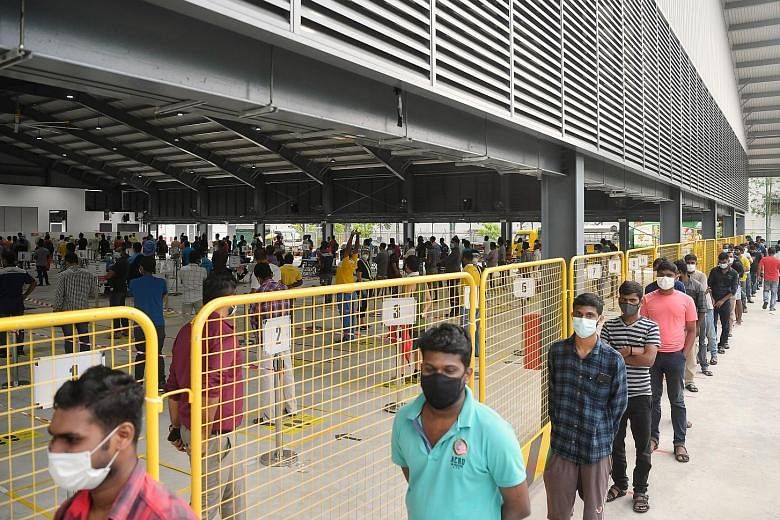Almost half of migrant workers staying in dormitories have had a Covid-19 infection, the authorities said yesterday.
As at Sunday, 54,505 such workers have tested positive for the virus via a polymerase chain reaction (PCR) test.
Another 98,289 had a positive result from a serology test, which checks for a previous infection.
This means 152,794 workers in dorms have tested positive in PCR or serology tests, or both.
They form 47 per cent of the 323,000 dormitory dwellers in Singapore, said the Ministry of Manpower (MOM) and the Ministry of Health (MOH) in a joint statement.
The ministries added that serology tests for about 65,000 workers in dorms who had not taken them before were still being carried out. "This will give us the full picture of the infection prevalence among our migrant workers," they said.
PCR tests are used to diagnose current or new infections. Serology tests identify those who have been infected in the past, by detecting the presence of Covid-19 antibodies in blood samples.
At a press conference by the multi-ministry task force on Covid-19 yesterday, Second Minister for Manpower Tan See Leng said the Government's testing and medical strategy had helped to achieve good health outcomes for migrant workers, with very low morbidity and mortality rates among them.
"It has also enabled us to better understand the prevalence of infection amongst our migrant workers," he added.
"This will go a long way, in the coming months ahead, in informing us and allowing us to refine our strategies to keep them safe against future outbreaks."
Dr Tan said Singapore has made significant strides since March, when the first Covid-19 infections were detected in dorms.
At the start of the outbreak, the top priority was to contain the spread of the virus, as well as take care of the health of those affected, he said.
Once this was managed in early June, the focus shifted to the clearing of workers and dorms so that recovered and infection-free workers could resume work safely.
By the end of May, the scientific literature had highlighted that a significant number of those infected did not have symptoms, but they still contributed to the spread of Covid-19.
Local and international data also showed that those infected could continue to shed non-infectious viral fragments for up to several months, even after recovery.
Therefore, an even more comprehensive testing strategy was needed to separate workers who had never been infected, or had the virus earlier but were no longer infectious, from those currently infected or harbouring the virus without any symptoms, Dr Tan said.
"This was why we made the decision to systematically screen all migrant workers living in dormitories to allow workers to return to work quickly and safely," he said, adding that a combination of PCR and serology tests was used.
By August, all migrant workers staying in dormitories had been tested at least once for Covid-19. "This gave us the assurance that the vast majority of infections have been contained," said Dr Tan.

Oct 13 was another significant milestone, as there were no new cases detected in dorms for the first time since March 25. He noted that new infections in dorms have continued to be low in the past two months.
By early last month, more than 98 per cent of this population had been cleared to resume work.
Dr Tan said the progress has been made possible with the help of stakeholders such as dormitory operators, employers and non-governmental organisations.
He also credited the nearly 3,000 officers and volunteers who formed an inter-agency task force to help with curbing the virus situation in dorms, as well as the workers themselves for their cooperation. "We could not have contained this virus without the determination, the cooperation, the patience and the understanding of the migrant workers in the dormitories," Dr Tan said.
But with all the efforts in the past months, Singapore has "just reached base camp", and the crisis is far from over.
"We still have to scale the mountain peak in terms of ensuring that as we open up safely, we will continue to implement a robust and an inclusive regime of vaccination and regular testing for all of our migrant workers, isolating and treating the affected ones, and doing aggressive contact tracing while keeping the rest of us safe," he added.
MOM and MOH said the vast majority of migrant workers in dorms who tested PCR-or serology-positive were asymptomatic or had very mild symptoms, based on a study of workers in purpose-built dorms who tested positive as at July 25.
Only about one in five of migrant workers living in such dorms had symptoms, with the remaining displaying very mild or no symptoms.
The ratio of those who are PCR-positive to serology-positive is 1:1.8.
This means that for every Covid-19 infection in the dormitories detected through PCR testing, another 1.8 cases were untested and undetected at the time, and were identified subsequently only through serology testing.
"This is not surprising as many migrant workers did not have any symptoms, and thus would not have sought treatment and received a PCR test in the process," said the ministries.
The ratio of 1:1.8 is comparable with the same ratio for the whole of South Korea, and lower than 1:4 in Spain and 1:15 in France, they said. "Our low ratio reflects the extensive testing that was carried out in dorms," the ministries added.
When it comes to the reporting of Covid-19 practices, the ministries said Singapore follows the World Health Organisation's criterion that only positive results from PCR tests are included in the case count, which ensures consistency in reporting cases across countries.
But a different approach is taken for serology tests, which are used to aid epidemiological investigations and to assess overall prevalence of infection within a population.
Most countries do serology testing only on a sampling basis, to estimate the prevalence of infections in a population, but Singapore went further to do serology tests on the entire population of migrant workers staying in dormitories, the ministries said.
"This was a unique aspect of our efforts to clear the dormitories of Covid-19," they added.


